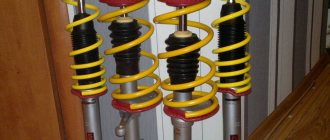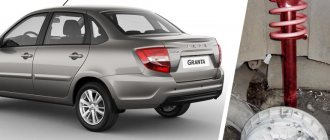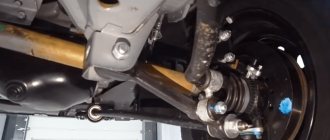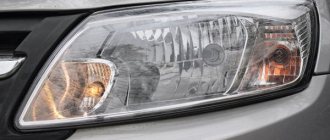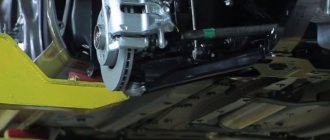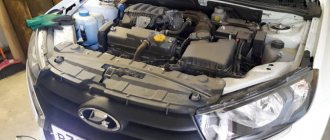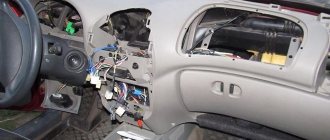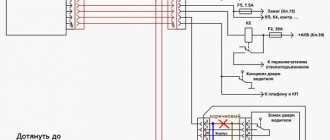The suspension in any car serves to ensure that on uneven road surfaces, the car goes as smoothly as possible, and the driver and passengers practically do not feel any vibrations and shocks. Also, vibration has a detrimental effect on the general condition of the car. For example, its screw connections may become loose over time, and moving parts: the hood, trunk, doors will sag or not close tightly due to bending of the hinges. Every year, the suspension design becomes more modernized, and the ride on such cars becomes more comfortable. This is very noticeable in foreign samples. But you and I will look at a domestic example - the Lada Granta car.
The suspension of the Lada Granta has a fairly modern design, far advanced in development compared to previous VAZ models. Let's look at what structural features it has, and what has changed in it over the years.
Before you understand the suspension structure, you need to divide it into front and rear. They are slightly different from each other, so we will look at them separately.
The front suspension has an independent structure consisting of two telescopic-hydraulic struts with shock-absorbing action. Each strut has a shock absorber spring.
If any of the wheels gets into a hole, the second wheel located on the same axle will remain in an independent position. In order to ensure that when driving on a flat road, both racks are located on the same straight line, a special device is installed between them - a stabilizer.
The steering knuckle is attached to the outer edge of the rack. On it, in turn, there is an adjusting screw responsible for the camber angle of the front wheels.
Instead of the old fastening, in the form of a tightly inserted bearing, on all Lada Granta cars, regardless of body type: sedan or liftback, a steel bushing was installed, which was vulcanized to the rubber support. It is thanks to this difference that such a suspension did not emit extraneous noise, and also did not have any play.
On the new suspension of the Lada Grant, in the sedan and liftback body, the bearing was installed in only one place - between the spring and the body support. Thus, the entire weight of the machine was concentrated on him, and kept him in a constant compressed position. This means that there was also no backlash, and along with it, extraneous noise.
The rear suspension of Grants, sedan and liftback, is also the same. It is very similar in design to previous models, starting with the VAZ 2108 and ending with Kalina and Priora. Essentially, the principle of operation is the same as that of the front suspension, with the difference that instead of a stabilizer, a semi-rigid beam is installed. That is why it cannot be called independent. The fastenings are located in the same way as in the front. So, the front suspension does not have any special differences from the rear, but still, there is a difference between them.
Possible faults
Malfunctions and breakdowns can occur in any car, especially with regard to the suspension. This is explained by the fact that the suspension endures constant vibration when driving, softens shocks, and takes the entire weight of the car, including passengers and luggage, on itself. Based on this, a Granta in a liftback body is more susceptible to breakdown than a sedan, since the liftback body has a larger luggage compartment designed for greater weight.
The first problem that is most often encountered is the presence of knocking or extraneous noise. In this case, it is necessary to check the shock absorbers, as they need timely replacement and can often fail. Also, the reason may be that the shock absorber mounting bolts are not fully tightened.
If this is not the case, then check the rubber bushings on the suspension support arms. They very often break when they fall into a hole, especially on a liftback body. Also, with a strong impact, not only the bushings can be damaged, but also the struts themselves. Then the repairs will be more serious and expensive.
The final cause of suspension knocking may be a broken spring. It is replaced literally within 5 minutes.
In addition to knocking noises, you need to check the suspension mechanism for leaks. If such traces are found, then this can only indicate one thing - a malfunction of the shock absorbers. If all the fluid leaks out and the shock absorber dries out, then when it hits a hole, the suspension will provide poor resistance, and the vibration from the impact will be very strong. The solution to this problem is quite simple - replace the worn element.
Since the Lada Granta in the liftback body is more subject to overloads, its owners often experience such trouble as: puncture of the rear suspension. This is due to exceeding the permissible weight on the rear axle of the car. With constant use in such conditions, shock absorbers and springs will very quickly become unusable.
The last malfunction that occurs on the Grant is that when braking or accelerating, the car pulls to the side. This indicates that on this side, one or two shock absorbers are worn out and sag somewhat more than the others. Because of this, the body has an overweight.
Cigarette lighter selection
Not many motorists and Lada Granta owners know that in addition to the standard VAZ cigarette lighter, there are several more analogues of this part.
Let's look at the catalog numbers and names of the spare parts:
- The original article number for the cigarette lighter is divided into 3 parts: 1. Movable part of the cigarette lighter (21230-3725200-00); 2. Cigarette lighter socket (21230-3725100-00); 3. Cigarette lighter illumination ring (21230-3725400-00). As you can see from the catalog number, the Lada Granta has a part from the Niva Taiga installed.
- An alternative to the standard Granta cigarette lighter can be the manufactured part (DA5100F0109).
Both parts fit perfectly into the seat and do not require modifications or modifications to the fastening.
Reasons for cigarette lighter failure
There are several reasons for the failure of the Lada Grant cigarette lighter:
- Short circuit caused by a failure of the on-board network.
- Actions of the passenger or driver that caused the part to break.
- Wear.
Bottom line
Having examined the structure of the Lada Granta suspension, we can safely say that the domestic manufacturer is not at all inferior to foreign models, and can easily compete with them on the global sales market.
The design of a car's suspension not only determines comfort when driving on the road, but also affects the control of the car. For the car owner, the reliability of the suspension and the price of maintenance are not the least important. The current Grant model belongs to the new generation of cars. Designers paid increased attention to this aspect when the Lada Granta suspension was developed.
The front suspension is equipped with the following type: independent with hydraulic shock absorbers, with two wishbones and a stabilizer bar. Additionally, the transverse arms are reinforced with special braces. The conical spring, inside of which the shock-absorbing strut is located, has coils of variable diameter.
The front support of the strut block has also been somewhat modified, which has a positive effect not only on the strength of the structure, but also eliminates extraneous squeaks and rattles that appeared on other Lada cars. The anti-roll bar is made of spring steel and is attached in its middle part to the body, and the end sections are attached to the lower arms.
- a power steering with a large compensating effect is installed;
- a short steering rack was used.
conclusions
Thus, replacing the cigarette lighter is one of the simplest operations in repairing this car.
Since time immemorial, automakers have introduced maintenance regulations for their creations. Carrying out maintenance of the Lada Granta is necessary to maintain the car in technically sound condition throughout its entire service life and to timely identify and eliminate current faults, which leads to minimizing the cost of repairing the Lada Granta.
By clicking on the link you can read general recommendations for maintenance and below see our offer for maintenance of Lada Granta.
Modernization of suspension systems
1. For front suspension:
2. For the rear suspension, the springs were strengthened and gas-filled shock absorbers were installed. It is worth noting that factory tuning of the suspension is combined with improved sound insulation of the car. With this modification, the car feels quite comfortable on the road up to 150 km/h, while coping well with cornering on almost any road surface.
A detailed analysis of the reliability of the suspension for the Lada Granta liftback is quite difficult to carry out. This is due to the short life of the car. Life tests of the machine are still ahead. However, based on reviews from owners and the results of warranty and service maintenance of these cars, we can characterize the main faults:
- loosening the anti-roll bar fixing bolts;
- failure of hydraulic shock absorbers (after 60-80 thousand km), leakage of shock absorbers;
- wear (increased clearance) of the front wheel bearings, which causes accelerated wear of the silent blocks of the levers;
- loss of spring stiffness (especially for springs with a smaller diameter);
- wear of the ball joints of the front suspension.
- the appearance of squeaks in the place where the shock absorber strut is attached;
- shock absorber failure;
- violation of wheel alignment angles, including due to violation of the adjustment of the clearance of the hub bearings or their destruction;
- Damage to the shock absorber protective covers.
This approach can easily be justified by the increased costs of deferred repairs. Worn bearings will place increased load on ball joints, rubber bushings of levers, and cause disruption of the alignment angles of the front wheels. Over time, the tires will begin to wear out faster. A sagging spring will not only lead to possible damage to the bumper on the first high curb. The shock absorber will wear out faster, and the car will lose comfort at high speeds.
Removing the rear suspension shock absorber strut on a Lada Granta car is done to replace a sagging or burst spring, as well as to replace the shock absorber itself or repair it if it is dismountable and you have the appropriate repair kit.
Prepare a standard set of tools and perform the following sequence of actions:
- Inside the car, fold down the back of the rear seat and use a flat screwdriver to pry off the rubber plug of the shock absorber strut cup.
- We remove the rubber plug, then use a socket and a regular open-end wrench to unscrew the nut of the upper fastening of the shock absorber rod to the car body.
- We install stops under the front wheels and hang the rear part of the body, remove the wheel from the side being repaired.
- Unscrew the nut of the bolt securing the lower shock absorber to the rear beam bracket.
- We remove the lower end of the rack from the bracket and remove it along with the spring.
- Remove the spring from the shock absorber along with its rubber spacer. Next, remove the bushing and lower cushion along with the boot from the rod. All rubber elements must be replaced if the rubber has lost its elasticity, is severely cracked, or has other defects. Don't forget to remove the rubber compression buffer from the boot.
- Having completed the necessary repairs or replacement of worn elements, we proceed to install the rack. The installation sequence is performed in the reverse order of removal. First of all, using insulating tape, fix the rubber spacer on the upper end of the spring.
- We put the spring on the strut so that its end fits neatly into the corresponding groove of the shock absorber support cup.
- When installing, make sure that the lower end of the spring faces the wheel.
At this point, the repair work on removing and installing the rear suspension shock absorber strut on the VAZ 2190 has been completed.
The rear suspension of the car is semi-independent, made on an elastic beam with trailing arms, coil springs and double-acting telescopic shock absorbers.
The rear suspension beam consists of two longitudinal arms connected by a U-shaped cross member.
This cross-section provides the connector (cross member) with greater bending rigidity and less torsional rigidity.
The connector allows the levers to move relative to each other within small limits. The levers are made of pipes of variable cross-section, which gives them the necessary rigidity
Brackets for attaching the shock absorber, rear brake shield and wheel hub axle are welded to the rear end of each lever.
At the front, the beam arms are bolted to removable brackets for the body side members.
The mobility of the levers is ensured by rubber-metal hinges (silent blocks) pressed into the front ends of the levers.
The lower shock absorber eye is attached to the beam arm bracket. The shock absorber is attached to the body by a rod with a nut.
The elasticity of the upper and lower connections of the shock absorber is provided by rod cushions and a rubber-metal bushing pressed into the eye.
The shock absorber rod is covered with a corrugated casing that protects it from dirt and moisture. In the event of suspension breakdowns, the stroke of the shock absorber rod is limited by a compression stroke buffer made of elastic plastic.
The suspension spring with its lower coil rests on the support cup (a stamped steel plate welded to the shock absorber body), and with its upper coil it rests against the body through a rubber gasket.
The rear wheel hub axle is installed on the flange of the beam arm (it is secured with four bolts).
The hub with a double-row roller bearing pressed into it is held on the axle by a special nut. The nut has an annular collar that securely locks the nut by jamming it into the groove of the axle.
The hub bearing is a closed type and does not require adjustment or lubrication during vehicle operation.
Rear suspension springs are divided into two classes: A
- more rigid,
B
- less rigid.
A springs
are marked with brown paint, class
B
- blue.
Springs of the same class must be installed on the right and left sides of the car.
Springs of the same class are installed in the front and rear suspension. B springs may be installed
in the rear suspension if class
A
.
A springs
It is not allowed on the rear suspension if class
B
.
Checking the suspension condition
You can evaluate the technical condition of the suspension while the car is moving. When driving at low speed on an uneven road, the suspension should work without knocks, squeaks and other extraneous sounds.
After driving over an obstacle, the car should not sway.
It is better to combine checking the suspension with checking the condition of the tires and wheel bearings.
One-sided tire tread wear indicates deformation of the rear suspension beam.
Execution Sequence
1. We prepare the car for work.
It is better to check the performance of shock absorbers after a long trip, until the working fluid in the shock absorbers has cooled down.
2. Vigorously swing the rear part of the car body in a vertical direction.
If, due to inertia, the body continues to oscillate (more than two: up and down) after it has stopped swaying, it means that one or both shock absorbers are faulty.
To identify a faulty shock absorber, we repeat the test, applying force first on one side of the car and then on the other.
This check can only identify faulty shock absorbers.
The effectiveness of vibration damping by shock absorbers can only be checked on a special stand.
3. Inspect the suspension shock absorbers - fluid leakage from the shock absorbers is not allowed.
Shock absorbers should be replaced as a pair, even if the second shock absorber on the rear suspension is working.
4. Visually check the condition of the rubber-metal hinges for fastening the shock absorbers 1 and the arms of the rear axle beam 2.
We replace hinges with one-sided bulging of rubber, tears and cracks.
5. Check the tightness of the nuts securing the suspension parts and tighten them if necessary.
6. Inspect the suspension parts. Deformation and fatigue cracks in suspension parts are not allowed.
We replace damaged parts.
Replace springs, like shock absorbers, in pairs.
| Tightening torques for rear suspension threaded connections | ||
| Name of units and parts | Tightening torque Nm (kgcm) | |
| Wheel bolts | 65,2-92,6 (6,7-9,5) | |
| Rear wheel bearing nut | 186,3-225,6 (19,0-23,0) | |
| Shock absorber lower mounting bolt nut to the rear suspension arm | 66,6-82,3 (6,8-8,4) | |
| Shock absorber rod mounting nut rear suspension to body | 50,0-61,7 (5,1-6,3) | |
| Lever mounting bolt nuts rear suspension to bracket | 66,6-82,3 (6,8-8,4) | |
| Lever bracket fastening nuts rear suspension to body | 27,4-34,0 (2,8-3,5) | |
It is more convenient to remove the rear beam of the Lada Granta on a lift. If it is not possible to place the car on a lift, carefully raise the rear of the car by placing a jack under the beam. Then install supports under the jack sockets on the car body. As a result, the rear of the car must be suspended. Before you hang the rear, remove the wheels. Without wheels, it will be more convenient for you and your assistants to operate the beam. Loosen and tighten wheel bolts only with the vehicle on the ground. The tightening torque of the bolts is 65–95 N m (6.5–9.5 kgf m).
First of all, we wanted to once again show the structure of the rear beam, which will allow you to evaluate where and how the beam is attached to the body and to other suspension elements.
First of all, when removing the beam, it is necessary to disconnect it from the rear shock absorbers (9) and brackets (2), which are attached to the body.
DIY puller
Dismantling and pressing in a new part are difficult stages of work, especially the last one. Therefore, the installation of silent blocks of the rear beam should be performed using a special device - a puller. You can make it yourself or ask a friend. With it you do not need to hit the parts with a hammer, so damage cannot be caused.
Device options:
- Small vices. They are put on the suspension part, and a tube is placed under one of the sides. It is important to install the second part so that it presses on the body of the part. But a piece of wood is installed between the vise lip and the part.
- Homemade device from scrap materials. This option involves turning and welding. Make a clamp from metal plates or improvised means. A hole is drilled in the base, where a nut is usually welded. A bolt is installed here, which serves as a press.
- Purchase of factory tools.
The option with a vice is the simplest and most reliable. A factory product costs money. If they are not there, but you have the skills and parts, then you can make the tool yourself. It is important that it can withstand high loads.
Design
Before you understand the suspension structure, you need to divide it into front and rear. They are slightly different from each other, so we will look at them separately.
The front suspension has an independent structure consisting of two telescopic-hydraulic struts with shock-absorbing action. Each strut has a shock absorber spring.
If any of the wheels gets into a hole, the second wheel located on the same axle will remain in an independent position. In order to ensure that when driving on a flat road, both racks are located on the same straight line, a special device is installed between them - a stabilizer.
The steering knuckle is attached to the outer edge of the rack. On it, in turn, there is an adjusting screw responsible for the camber angle of the front wheels.
Instead of the old fastening, in the form of a tightly inserted bearing, on all Lada Granta cars, regardless of body type: sedan or liftback, a steel bushing was installed, which was vulcanized to the rubber support. It is thanks to this difference that such a suspension did not emit extraneous noise, and also did not have any play.
On the new suspension of the Lada Grant, in the sedan and liftback body, the bearing was installed in only one place - between the spring and the body support. Thus, the entire weight of the machine was concentrated on him, and kept him in a constant compressed position. This means that there was also no backlash, and along with it, extraneous noise.
The rear suspension of Grants, sedan and liftback, is also the same. It is very similar in design to previous models, starting with the VAZ 2108 and ending with Kalina and Priora. Essentially, the principle of operation is the same as that of the front suspension, with the difference that instead of a stabilizer, a semi-rigid beam is installed. That is why it cannot be called independent. The fastenings are located in the same way as in the front. So, the front suspension does not have any special differences from the rear, but still, there is a difference between them.
